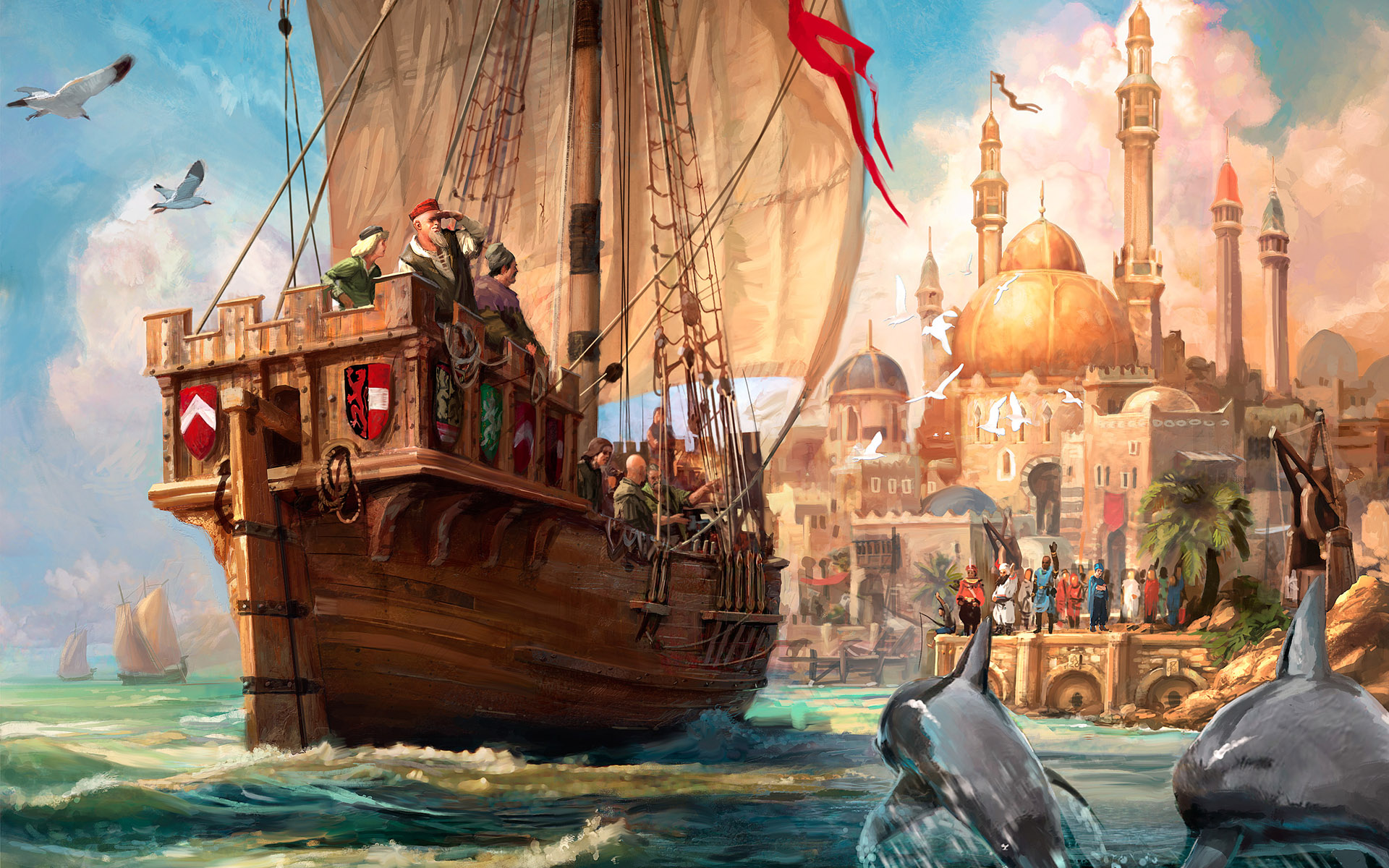The String of Pearls
The Bronze Age begins
Nascent civilisations start to use magic and labour to manipulate metals into tools. The population of coastal and river settlements explode as farming and fishing undergo a revolution. Caravans now travel to distant lands and knowledge of the world flourishes. But there are still dark places, untrodden and unsailed. In the vastness of the Pearl Ocean - the vastest of the unknown regions of the globe - is born a civilisation that is still told of, even as elves and men race to be the first to see planet Aris from the stars. This is the legend of the Merchant Empire - Olkiria.Summary
In popular culture the Olkirian Empire, or the Merchant Empire, was the first and only civilisation to monopolise sea trade in the Pearl Ocean.
The chain of trade routes connecting the many islands of the Empire traversed the Ocean and connected the human and elven civilisations for the first time in history. It became known as the legendary "String of Pearls". The wealth of Olkiria was said to be so immeasurably great that its Emperor - Birmud -was able to fund the construction of a floating city-palace that travelled between major port cities and created prosperity as well as discord according to his whim. Stories of his visit to the elven port city of Mizarin tell that he spent so much gold during his visit there that the local kingdom went bankrupt due to the crash of the gold price and the ensuing hyperinflation crisis.
It is also widely mentioned in popular culture that the Merchant Empire did not have its own naval force. It behaved essentially like a massive company instead of a state and thus it employed privateers from all nationalities to accompany trade ships in their lucrative tours around the world.
It is believed that the Emperor Birmud always knew who the enemies of his trade colossus were, and that he would always know which ship needed to prepare for an ambush. When he died, his trade fleet incurred massive losses to pirates ships and the fleets of envious kings. Without the pay from profits of commerce, the privateers that kept the trade routes safe turned to piracy. Islands were abandoned due to starvation and the ocean became once again too dangerous to sail.
Historical Basis
Cross references of ancient documents from guilds, shipping and mercenary companies as well as dealings with regional lords originating on all coasts of the Pearl Ocean confirm that there was in fact a sea faring civilisation in the bronze age that mastered deep sea sailing.
Reconstruction of Olkirian vessels in model ships seem to indicate that a combination of very advanced knowledge in astronomy, physics and enchanting allowed for rapid maritime expansion, especially along the shallow sea of eroded islands along the tectonic fault lines in the Pearl Ocean. Military ships were equally well prepared and are thought to have been able to outmatch contemporary vessels in speed, manoeuvring and resilience.
The most well accepted theory on the fate of the Olkirian empire is that the massive influx of profits to the capital - located somewhere near the coast of the Orthean continent - led to unequal distribution of wealth among the empire and, ultimately, to its disintegration after a succession of civil wars and economic/military intervention from competing continental powers.
Olkirians were predominantly Orthean human although a significant part of the population consisted on early subs-species of the fast evolving An'Aldar (also known as primordial elves). The Empire was surprisingly multicultural and progressive for its time. It was also incredibly prosperous with estimates that it might have been the first civilisation in Aris to reach a total of 10 million citizens.
Private expeditions in search of ancient Olkirian island cities become much more frequent after the recent development of magical navigation systems at sea. Some artefacts have been found, but the fabled sailing palace of Birmud - "the largest pearl in the string" - is yet to be discovered.
Spread
In the vast pangea of Aris it is often heard that the only real ocean is the Pearl Ocean.
All sea-faring civilisations have traded popular tales of encounters with Olkirian merchants even after the downfall of the mythical empire, millennia ago. Fishermen's tales speak of ghost galleons still sailing in search of Olkiria's sunken capital so they can unload their untold riches. Even sailors in modern ironclad destroyers fear undead Olkirian privateers. Some historians even believe that there are lessons in economics to be learned from studying the old merchant empire.
In Literature
Descriptions in literature of the Olkirian Empire became widely popular during the Renaissance of the Post Daemonic Incursion. The surge of early globalisation and the age of ultramarine colonial empires was heavily inspired in the Olkirian legend, much more so than the ancient civilisations contemporary with the Merchant Empire.
In Art
As with most literature Olkirian on customs, the majority of produced art is dated to the Renaissance. In fact, the most well known art depicting the Merchant Empire is a collection of ceiling tapestries of a scene at sea (with a total surface area of 79 square meters) produced by the humans of the Eastern Kingdoms in the year of 144 ADI.
Date of First Recording
First recordings of vessels capable of deep sea sailing (widely accepted to be Olkirian) are from some time in between 2600 and 2500 BDI.
Date of Setting
2500 - 1900 BDI
Remove these ads. Join the Worldbuilders Guild









Comments